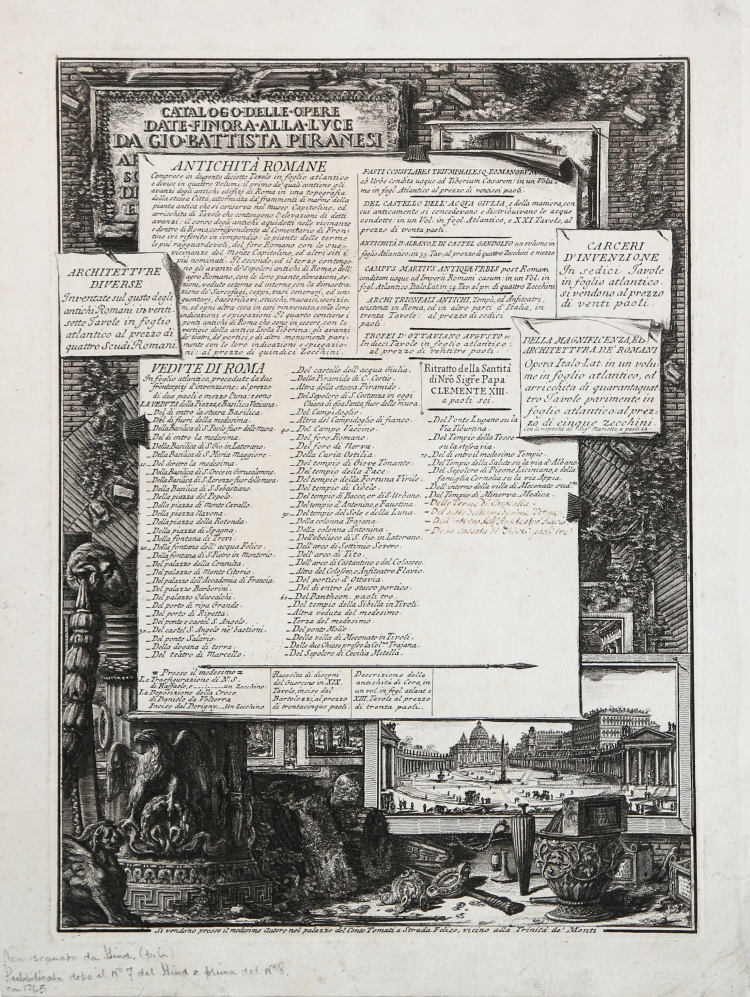




| Reference: | S41928 |
| Author | Giovan Battista PIRANESI |
| Year: | 1767 ca. |
| Printed: | Rome |
| Measures: | 293 x 400 mm |



| Reference: | S41928 |
| Author | Giovan Battista PIRANESI |
| Year: | 1767 ca. |
| Printed: | Rome |
| Measures: | 293 x 400 mm |
Etching and engraving, circa 1767, signed in plate top left.
Example of the eleventh state of thirty-six described in Andrew Robison's very recent essay (March 2022) dated 1766. Compared to the previous state of the Catalogo, we find the presence, among the Vedute di Roma - now 74 - of the view of the Del Tempio di Minerva Medica Medica which was made at the end of 1766.
However, the handwritten, autograph addenda of 4 Vedute di Roma places this example between the eleventh and twelfth state described by Robison. If from a filing point of view it corresponds to the eleventh state, the author's handwritten addenda makes it an update of that issue.
A very good impression, printed on laid paper with “double encircled fleur de lys” watermark, with margins, trace of glue on the back, otherwise in good condition.
A common custom among many editors in the eighteenth century was to compile and print catalogues or price lists of the graphic works they sold with the promotional intent of advertising them, uphold orders and obtain subscriptions. Piranesi did not limit himself to a common written catalogue but even published an illustrated one, better known as the engraved catalogue, which he issued for the first time in 1761. This happened in the circumstance of his moving to new premises at the Tomati Palace. The first catalogue included the list of the fifty-nine views belonging to the collection Vedute di Roma, which he had created up to then, together with an inventory of other published books that featured his prints. This catalogue was constantly updated by adding new items that were put on sale, giving rise to a number of different states, of which 36 are currently known.
The engraved catalogue is of primary importance for the dating of Piranesi's works, an essential means of study and research as the analysis of its states allows the approximate chronological classification of all of the artist's later works. When creating this work, which is correctly considered as another of his masterpieces, Piranesi focused his studies on its decorative aspects. He used the same technique that can be found in some of his books, creating a trompe-l'oeil effect on an architectural background, depicting pins which seemed to fasten a number of cartouches with titles pertaining to his works. The foreground consisted of ruins and sculptural fragments while an additional white space was included on purpose to allow for the addition of new items in the future. The items included in this catalogue are considerably rarer than Piranesi's other engraving, probably because they were printed in a smaller number, as well as for the reason that they were considered as short-lived promotional material, and therefore were not preserved. Some of these bear dedications to the artist's friends and benefactors, while, on other ones, pen-written notes enumerating the latest items, often by the artist's own hand, can be seen.
Extremely rare example of the Piranesi’s Catalogo delle Opere.
Bibliografia
Andrew Robison, Piranesi’s Catalogo delle Opere, in The Burlington Magazine, n. 164 (2022), pp. 230-245, XI/XXXVI; H. Focillon, Giovan Battista Piranesi 1720-1778 (1918): n. 1; A. M. Hind, Giovanni Battista Piranesi. A critical study with a list of his published works and detailed catalogues of the Prisons and Views of Rome (1922): p. 6; cf. K. Meyer-Haunton in Piranesi, Incisioni, Rami, Legature, Architetture.
Giovan Battista PIRANESI (Mogliano Veneto 1720 - Roma 1778)
|
Italian etcher, engraver, designer, architect, archaeologist and theorist. He is considered one of the supreme exponents of topographical engraving, but his lifelong preoccupation with architecture was fundamental to his art. Although few of his architectural designs were executed, he had a seminal influence on European Neo-classicism through personal contacts with architects, patrons and visiting artists in Rome over the course of nearly four decades. His prolific output of etched plates, which combined remarkable flights of imagination with a strongly practical understanding of ancient Roman technology, fostered a new and lasting perception of antiquity. He was also a designer of festival structures and stage sets, interior decoration and furniture, as well as a restorer of antiquities. The interaction of this rare combination of activities led him to highly original concepts of design, which were advocated in a body of influential theoretical writings. The ultimate legacy of his unique vision of Roman civilization was an imaginative interpretation and re-creation of the past, which inspired writers and poets as much as artists and designers.
|
Giovan Battista PIRANESI (Mogliano Veneto 1720 - Roma 1778)
|
Italian etcher, engraver, designer, architect, archaeologist and theorist. He is considered one of the supreme exponents of topographical engraving, but his lifelong preoccupation with architecture was fundamental to his art. Although few of his architectural designs were executed, he had a seminal influence on European Neo-classicism through personal contacts with architects, patrons and visiting artists in Rome over the course of nearly four decades. His prolific output of etched plates, which combined remarkable flights of imagination with a strongly practical understanding of ancient Roman technology, fostered a new and lasting perception of antiquity. He was also a designer of festival structures and stage sets, interior decoration and furniture, as well as a restorer of antiquities. The interaction of this rare combination of activities led him to highly original concepts of design, which were advocated in a body of influential theoretical writings. The ultimate legacy of his unique vision of Roman civilization was an imaginative interpretation and re-creation of the past, which inspired writers and poets as much as artists and designers.
|